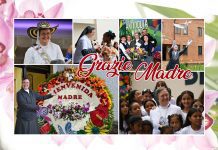Brazil. “Blessed Laura Vicuña. Uma história de fé e graças realizadas pela intercessão da menina bem-aventurada” (Blessed Laura Vicuña. A story of faith and graces made through the intercession of the young blessed”) is the title of an lively biography of this teenager published by Life Editora (Campo Grande, MS – 2024), enriched with archive photos and a collection of graces obtained through her intercession, made by Sister Maria Nilda Cavalcante, Daughter of Mary Help of Christians of Our Lady Aparecida Province of São Paulo (BAP).
January 22, 1904, in Junín de Los Andes, Argentina, a little girl of just under thirteen years old dies. She is Laura do Carmo Vicuña, born in Santiago de Chile on 5 April 1891. Her story is revealed in the following memorable years, to the point that her educators decide to start the cause of her beatification. On 3 September 1988, Saint John Paul II proclaimed her Blessed, proposing her as an example of evangelical life on the “Hill of Youth Beatitudes” (Colle Don Bosco) on the occasion of the celebrations for the centenary of the death of Saint John Bosco.
Laura Vicuña continues to fascinate and manifest the signs of her protection to those who with faith, ask for her intercession to obtain God’s help, as this biography testifies.
FMA since 1956, Sister Maria Nilda Cavalcante, after formation in Philosophy, Pedagogy, Management, and Educational Guidance, carried out teaching and coordination tasks in schools and universities, social works and hospitals, always combining evangelization and education. In the small library of Mary Help of Christians School of Campo Grande, where she now lives, assisted by Deborah Andrade, journalist and writer, Sister Maria Nilda edited this volume, fruit of faith and gratitude to God, hers and of senator Nelsinho Trad.
In the preface, Nelsinho Trad – doctor and senator of the Republic for Mato Grosso do Sul, former student of Colégio Dom Bosco of Campo Grande asks, “Was Laura a girl like all the others? In principle yes, but in divine plans no. She has become an instrument of God to perform miracles for our sake. More precisely, I write to bear witness and tell what I have experienced, and still live, when for the first time at the age of eleven, I invoked the intercession of Laura and received from God an unlikely healing, in the eyes of skeptics.” It was Sister Maria Nilda Cavalcante Rangel who introduced Laura, not yet Blessed, to the Trad family.
More than half a century later, Nelsinho Trad recalls that “the grace granted to me has made Blessed Laura Vicuña a constant reference for my family, from generation to generation: my mother, father, uncles, cousins, wife, and children.” For this reason, he decides to go with his wife and younger daughter to the Colegio María Auxiliadora, the place where Laura’s remains are located in Bahía Blanca, about 600 kilometers from Buenos Aires, Argentina. It is the first of many other pilgrimages that Nelsinho Trad makes to Laura’s urn.
Beyond this, Sister Maria Nilda tells the stories of Laura Siufi, Luci Heritier, Inah Barbosa dos Anjos who have received singular and unforgettable favors through the intercession of Laura. The book, in addition to telling the story of Laura’s life on earth, wants to dwell on the traces that her presence leaves in the lives of those who have known her and who invoke her.
Interesting is the choice to tell the life of Mrs. Mercedes, Laura’s mother, in a chapter entitled, “Mercedes and the flight towards freedom”. Her daughter had offered her own life for her to return to the fullness of Christian life and break the unhealthy bond with Manuel Mora, a rich rancher who had welcomed them into his estate when they had to leave Chile.
There follows a chapter dedicated to the stages of the canonical process until beatification; one dedicated to research on the portrait of Laura; and one that describes the translation of the urn with the relics to “Bahía Blanca, her last dwelling.”
In the volume, there are references to the figures of Daughters of Mary Help of Christians and Salesians of Don Bosco who contributed to Laura’s education and who spread her fame, committing themselves to her cause of beatification.
The Provincial of the BAP Province, Sister Alaíde Deretti, in inviting to read the book writes, “Each chapter of this book will move you. (…) We must keep alive her memory and her spiritual achievements. By sacrificing her life for the salvation of her mother, Laura became an instrument of the Lord for the realization of graces for love towards us, and left humanity an extraordinary example of courage, humility, faith, and devotion to the Way of Jesus. We know that from above, she cares lovingly for all who believe in the power of God.”
A few days before the liturgical memorial of the young FMA Past Pupil, the publication of this volume is also an invitation not to tire of invoking and recounting, to seek and document the protection of Laura and the many examples of holiness that enrich the Institute of the Daughters of Mary Help of Christians.




















